10+ Exit Strategy Examples to Download
It is an undeniable truth that risk is consistent in a company and its ventures. Whatever business it is, there is always a chance that it will not fulfill its goals. That’s why Exit Strategies are necessary. This strategy ensures that there is a place for you to bounce back. That your failures can become learnings instead. However, if you’re a new businessman and find yourself lost in creating your Exit Strategy. You’ve come to the right place. We can assure you that you can craft the most exceptional exit strategy using our ready-made samples and thorough guide below. Check them out.
10+ Exit Strategy Examples
1. Exit Strategy Template
2. Business Exit Strategy
3. Sample Exit Strategy
4. Exit Strategy Example
5. Project Exit Strategy
6. Basic Exit Strategy
7. Exit Strategies for Business
8. Exit Strategy in PDF
9. Covid-19 Exit Strategy
10. Business Exit Strategy Example
11. Exit and Sustainability Strategy
What is an Exit Strategy?
An exit strategy is a strategy that a business founder plans when certain conditions happen within the company. In this way, the founder can still provide him or herself a leeway when unwanted situations surface.
What are some exit strategies?
The art of commerce has been around since then. The economy became an aspect of governance that dictates the rise and fall of nations. Nonetheless, it is necessary for business individuals to always have a margin when things don’t go right. So listed below are some of the strategies that people can use.
-
Management Buyout
Management Buyout happens when a business or corporation’s executives combine their assets to acquire the whole or part of the business. In this way, they will be fully responsible for their investments and fight hard to keep the company afloat.
-
Outside Sale
As the name suggests, Outside Sale or private equity is about selling part or the whole company to an unaffiliated group or individuals. In this way, the company’s shares are not open for the public, but only to a few individuals.
-
Initial Public Offering
The IPO is a type of exit strategy that does not provide you with immediate liquidity. However, your profits will be better in the long run. This is the strategy that allows outside investors to your company. Although they can only buy limited stocks, you still have more influence within the company.
-
Transfer to Family
According to CNBC, at least 16 percent of company owners expect to pass on their work to their families, which could also be you. If you think that what you created is better for your family, then you can do this strategy.
How to Create an Exit Strategy?
Whether you are a startup with venture capital for an ambitious endeavor or an old merchant past his prime, one thing is certain. You need an exit strategy. In this way, you can still be sure that you have a roof above your head, whatever happens. If you’re here to learn how to create an Exit Strategy, we provided you with excellent tips that will surely help you win.
Step 1: Know Your Position
How much money do you have personally? How about the company? You should liquidate your finances before you start determining the type of exit plan you want to have. Not only will you save yourself for your exit, but you will also keep your influence within the company.
Step 2: Choose a Fitting Plan
Although there’s a lot of exit strategy in the market. People even sell strategy templates for them. However, it is your decision to choose the most appropriate plan. Do you go with succession or IPO? And if IPO, do you think you have the perfect pitch deck for investors and M&A?
Step 3: Meet Your Investors
If your company already has investors, you should make sure to meet them and inform them of your decision. Some of them may opt to liquidate their funds, and that could be depressing. However, they also, like you, have exit strategies.
Step 4: Tell The Team
The people you are wholly responsible for in the entire business is your team. This not only involves the management but also the regular employee. So make sure that you tell them, and you inform them of the change in the leadership. You should make sure that you already have new leadership before you do the meeting.
Step 5: Notify Your Costumers
If your business involves millions of customers, most of them wouldn’t really care or mind leadership change. However, for a company that produces limited products, your customer deserves a note. By doing this, you uplift your company’s professionalism in the market and keep the new administration’s customers.
FAQs
Why are exit strategies important?
Exit strategies are important to ensure that there will be a smooth and peaceful transition within the company. It also ensures the continuity of the company as a whole. Lastly, it guarantees the previous leader’s reward for his success.
Is an IPO an exit strategy?
Yes. An IPO is an exit strategy as it allows the founder or the leader to leave the spot. In this way, the joint venture or project can keep on even with less input from the previous executive. An IPO also allows the business stocks to go public, which guarantee’s investment for any upgrades.
What is an exit plan?
An exit plan is the same as an exit strategy. Basically, you’re planning to leave the company to other people while ensuring that it will not have any slides in the transition.
With the rise of capitalist, the business world became invasive. However, it does not necessarily mean that they won’t allow themselves leeway when the going gets. In fact, it’s the opposite exit strategies are necessary to keep the market competitive. Whether you are looking at the real estate, transportation, beauty, and food industry, companies’ going and coming are necessary.
10+ Exit Strategy Examples to Download

It is an undeniable truth that risk is consistent in a company and its ventures. Whatever business it is, there is always a chance that it will not fulfill its goals. That’s why Exit Strategies are necessary. This strategy ensures that there is a place for you to bounce back. That your failures can become learnings instead. However, if you’re a new businessman and find yourself lost in creating your Exit Strategy. You’ve come to the right place. We can assure you that you can craft the most exceptional exit strategy using our ready-made samples and thorough guide below. Check them out.
10+ Exit Strategy Examples
1. Exit Strategy Template
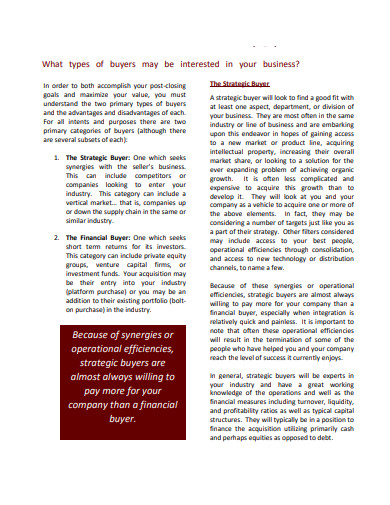
paramaxcorp.com
Details
File Format
PDF
Size: 786 KB
2. Business Exit Strategy
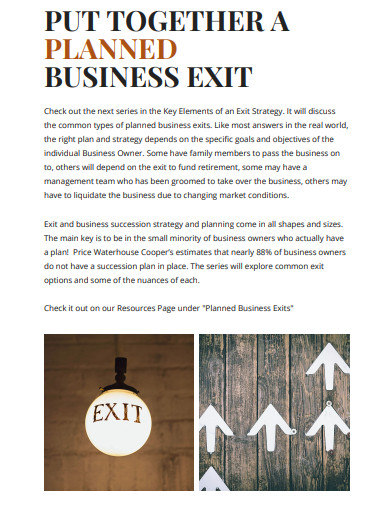
squarespace.com
Details
File Format
PDF
Size: 14 MB
3. Sample Exit Strategy

wcfia.harvard.edu
Details
File Format
PDF
Size: 238 KB
4. Exit Strategy Example

ebf.eu
Details
File Format
PDF
Size: 448 KB
5. Project Exit Strategy

undp-drp.org
Details
File Format
PDF
Size: 139 KB
6. Basic Exit Strategy
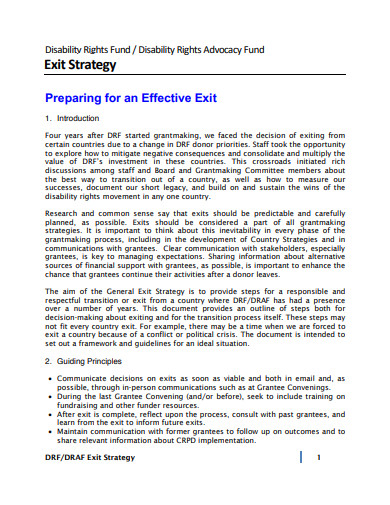
disabilityrightsfund.org
Details
File Format
PDF
Size: 81 KB
7. Exit Strategies for Business
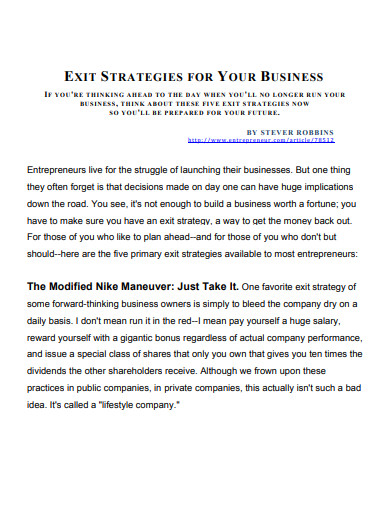
yourfranchisespecialist.com
Details
File Format
PDF
Size: 1 MB
8. Exit Strategy in PDF
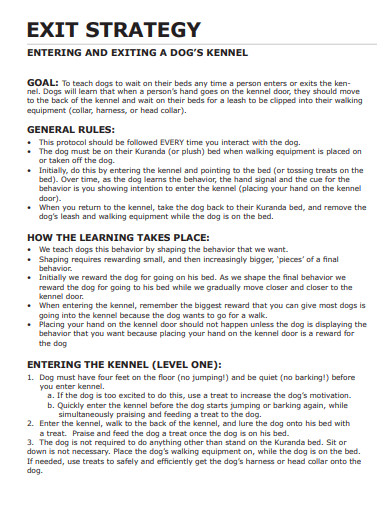
sheltermedicine.vetmed.ufl.edu
Details
File Format
PDF
Size: 307 KB
9. Covid-19 Exit Strategy
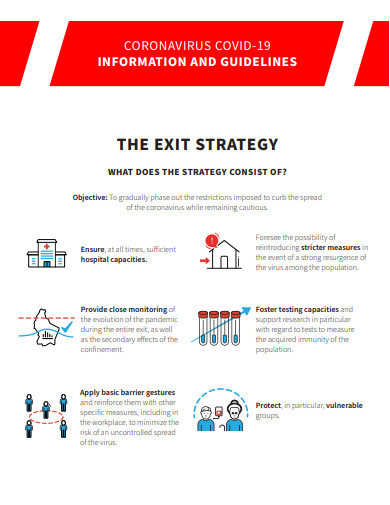
msan.gouvernement.lu
Details
File Format
PDF
Size: 50 KB
10. Business Exit Strategy Example

esca.us
Details
File Format
PDF
Size: 304 KB
11. Exit and Sustainability Strategy

unodc.org
Details
File Format
PDF
Size: 590 KB
What is an Exit Strategy?
An exit strategy is a strategy that a business founder plans when certain conditions happen within the company. In this way, the founder can still provide him or herself a leeway when unwanted situations surface.
What are some exit strategies?
The art of commerce has been around since then. The economy became an aspect of governance that dictates the rise and fall of nations. Nonetheless, it is necessary for business individuals to always have a margin when things don’t go right. So listed below are some of the strategies that people can use.
Management Buyout
Management Buyout happens when a business or corporation’s executives combine their assets to acquire the whole or part of the business. In this way, they will be fully responsible for their investments and fight hard to keep the company afloat.
Outside Sale
As the name suggests, Outside Sale or private equity is about selling part or the whole company to an unaffiliated group or individuals. In this way, the company’s shares are not open for the public, but only to a few individuals.
Initial Public Offering
The IPO is a type of exit strategy that does not provide you with immediate liquidity. However, your profits will be better in the long run. This is the strategy that allows outside investors to your company. Although they can only buy limited stocks, you still have more influence within the company.
Transfer to Family
According to CNBC, at least 16 percent of company owners expect to pass on their work to their families, which could also be you. If you think that what you created is better for your family, then you can do this strategy.
How to Create an Exit Strategy?
Whether you are a startup with venture capital for an ambitious endeavor or an old merchant past his prime, one thing is certain. You need an exit strategy. In this way, you can still be sure that you have a roof above your head, whatever happens. If you’re here to learn how to create an Exit Strategy, we provided you with excellent tips that will surely help you win.
Step 1: Know Your Position
How much money do you have personally? How about the company? You should liquidate your finances before you start determining the type of exit plan you want to have. Not only will you save yourself for your exit, but you will also keep your influence within the company.
Step 2: Choose a Fitting Plan
Although there’s a lot of exit strategy in the market. People even sell strategy templates for them. However, it is your decision to choose the most appropriate plan. Do you go with succession or IPO? And if IPO, do you think you have the perfect pitch deck for investors and M&A?
Step 3: Meet Your Investors
If your company already has investors, you should make sure to meet them and inform them of your decision. Some of them may opt to liquidate their funds, and that could be depressing. However, they also, like you, have exit strategies.
Step 4: Tell The Team
The people you are wholly responsible for in the entire business is your team. This not only involves the management but also the regular employee. So make sure that you tell them, and you inform them of the change in the leadership. You should make sure that you already have new leadership before you do the meeting.
Step 5: Notify Your Costumers
If your business involves millions of customers, most of them wouldn’t really care or mind leadership change. However, for a company that produces limited products, your customer deserves a note. By doing this, you uplift your company’s professionalism in the market and keep the new administration’s customers.
FAQs
Why are exit strategies important?
Exit strategies are important to ensure that there will be a smooth and peaceful transition within the company. It also ensures the continuity of the company as a whole. Lastly, it guarantees the previous leader’s reward for his success.
Is an IPO an exit strategy?
Yes. An IPO is an exit strategy as it allows the founder or the leader to leave the spot. In this way, the joint venture or project can keep on even with less input from the previous executive. An IPO also allows the business stocks to go public, which guarantee’s investment for any upgrades.
What is an exit plan?
An exit plan is the same as an exit strategy. Basically, you’re planning to leave the company to other people while ensuring that it will not have any slides in the transition.
With the rise of capitalist, the business world became invasive. However, it does not necessarily mean that they won’t allow themselves leeway when the going gets. In fact, it’s the opposite exit strategies are necessary to keep the market competitive. Whether you are looking at the real estate, transportation, beauty, and food industry, companies’ going and coming are necessary.

